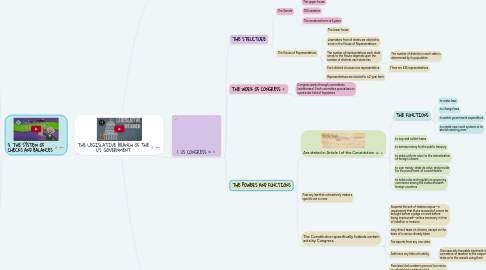
1. A bill is introduced
1.1. The bill is referred to the Committee. If approved it goes to Congress for review
1.1.1. Congress
1.1.1.1. If one house of Congress approves the bill, it goes to the other house and vise-versa
1.1.1.1.1. If both houses approve the bill, it goes to the President of the US who decides to either sign the bill or veto the bill
2. 3. THE SYSTEM OF CHECKS AND BALANCES
2.1. LEGISLATIVE VS EXECUTIVE
2.1.1. Legislative
2.1.1.1. Congress approves presidential appointments
2.1.1.1.1. So, the President CANNOT chose Cabinet Members, Supreme Court Justices, etc. without the approval of the Senate
2.1.1.2. Congress provides advice and consent to ratify any treaties
2.1.1.3. Congress holds the sole power to declare war
2.1.1.4. Congress controls the budget and money used to fund executive actions
2.1.1.4.1. So, the President CANNOT decide how federal money will be spent
2.1.1.5. Congress may pass laws by overriding a presidential veto
2.1.1.6. Congress can impeach and remove the president from office
2.1.2. Executive
2.1.2.1. The President of the USA may veto bills passed by Congress
2.1.2.1.1. BUT Congress may override presidential veto with a two-thirds vote in both the Senate and the House of Representatives
2.1.2.2. May propose legislation to Congress
2.1.2.2.1. For example, some important bills are introduced at the request of the President
2.2. LEGISLATIVE VS JUDICIAL
2.2.1. Legislative
2.2.1.1. Congress can change laws
2.2.1.2. Congress can initiate a constitutional amendment
2.2.1.3. Congress must approve appointed judges
2.2.1.4. Congress can restrict jurisdiction of courts to hear certain types of cases
2.2.1.5. Congress can create new court systems or abolish existing ones
2.2.1.6. Congress can impeach judges and remove them from office
2.2.2. Judicial
2.2.2.1. The Supreme Court can declare laws passed by Congress and signed by the President unconstitutional
2.2.2.2. The Supreme Court can declare presidential acts unconstitutional
3. 1. US CONGRESS
3.1. THE STRUCTURE
3.1.1. The Senate
3.1.1.1. The upper house
3.1.1.2. 100 senators
3.1.1.3. The senatorial term is 6 years
3.1.2. The House of Representatives
3.1.2.1. The lower house
3.1.2.2. Lawmakers from all states are elected to serve in the House of Representatives
3.1.2.3. The number of representatives each state sends to the House depends upon the number of districts each state has
3.1.2.3.1. The number of districts in each state is determined by its population
3.1.2.4. Each district chooses one representative
3.1.2.4.1. There are 435 representatives
3.1.2.5. Representatives are elected to a 2-year term
3.2. THE WORK OF CONGRESS
3.2.1. Congress works through committees (workhorses). Each committee specializes on a particular field of legislature
3.3. THE POWERS AND FUNCTIONS
3.3.1. Are stated in Article I of the Constitution
3.3.1.1. THE FUNCTIONS
3.3.1.1.1. to make laws
3.3.1.1.2. to change laws
3.3.1.1.3. to watch government expenditure
3.3.1.1.4. to create new court systems or to abolish existing ones
3.3.1.2. to levy and collect taxes
3.3.1.3. to borrow money for the public treasury
3.3.1.4. to make uniform rules for the naturalization of foreign citizens
3.3.1.5. to coin money, state its value, and provide for the punishment of counterfeiters
3.3.1.6. to make rules and regulations governing commerce among the states and with foreign countries
3.3.2. Pass any law that retroactively makes a specific act a crime
3.3.3. The Constitution specifically forbids certain acts by Congress
3.3.3.1. Suspend the writ of habeas corpus—a requirement that those accused of crimes be brought before a judge or court before being imprisoned—unless necessary in time of rebellion or invasion
3.3.3.2. Levy direct taxes on citizens, except on the basis of a census already taken
3.3.3.3. Tax exports from any one state
3.3.3.4. Authorize any titles of nobility
3.3.3.4.1. Give specially favorable treatment in commerce or taxation to the seaports of any state or to the vessels using them
3.3.3.5. Pass laws that condemn persons for crimes or unlawful acts without a trial

